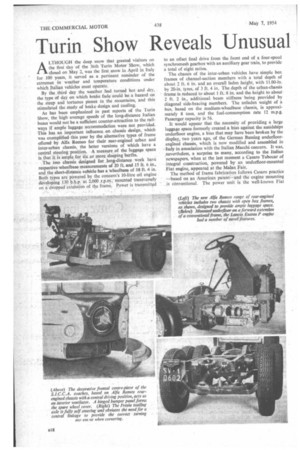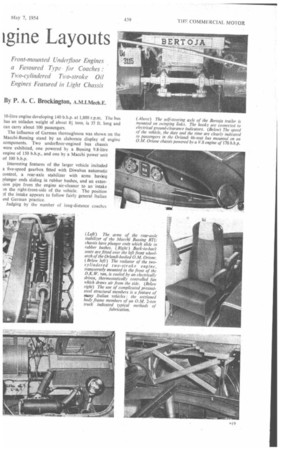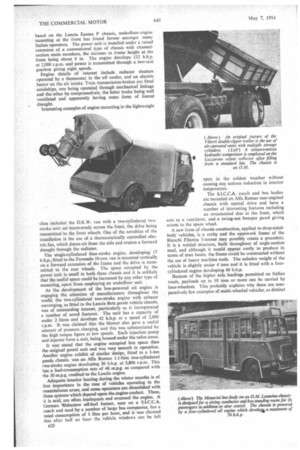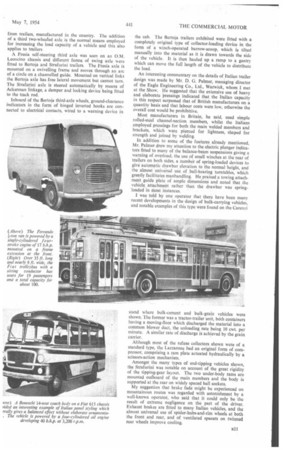Turin Show Reveals Unusual [gine Layouts
Page 64

Page 65

Page 66

Page 67

If you've noticed an error in this article please click here to report it so we can fix it.
Front-mounted Underfloor Engines a Favoured Type • for Coaches : Two-cylindered Two-stroke Oil Engines Featured in Light Chassis
By P. A. C. Brockington, A.M.I.Mech.E. ALTHOUGH the deep snow that greeted visitors on the first day of the 36th Turin Motor Show, which closed on May 2, was the first snow in April in Italy for 100 years, it served as a pertinent reminder of the extremes in weather and temperature conditions under which Italian vehicles must operate.
By the third day the weather had turned hot and dry, the type of day on which brake fade could be a hazard on the steep and tortuous passes in the mountains, and this stimulated the study of brake design and cooling.
As has been emphasized in past reports of the Turin Show, the high average speeds of the long-distance Italian buses would not be a sufficient counter-attraction to the railways if ample luggage accommodation were not provided. This has an important influence on chassis design, which was exemplified this year by the alternative types of frame offered by Alfa Romeo for their rear-engined urban and inter-urban chassis, the latter versions of which have a central steering position. A measure of the luggage space is that it is ample for six or more sleeping berths.
The two chassis designed for long-distance work have respective wheelbase measurements of 20 ft. and 15 ft_ 6 in., and the short-distance vehicle has a wheelbase of 18 ft. 4 in. Both types are powered by the concern's 10-litre oil engine developing 130 b.h.p. at 2,000 r.p.m., mounted transversely on a dropped extension of the frame. Power is transmitted to an offset final drive from the front end of a four-speed synchromesh gearbox with an auxiliary gear train, lo provide a total of eight ratios.
The chassis of the inter-urban vehicles have simple box frames of channel-section members with a total depth of about 2 ft. 6 in. and an overall laden height, with 11.00-in. by 20-in. tyres, of 3 ft. 4 in. The depth of the urban-chassis frame is reduced to about 1 ft_ 8 in. and the height to about 2 ft. 2 in., additional beam stiffness being provided by diagonal side-bracing members. The unladen weight of a bus, based on the medium-wheelbase chassis, is approximately 8 tons, and the fuel-consumption rate 12 m.p.g. Passenger capacity is 56.
It would appear that the necessity of providing a large luggage space formerly created a bias against the amidships underfloor engine, a bias that may have been broken by the display, two years ago, of the German Bussing underfloorengined chassis, which is now modified and assembled in Italy in association with the Italian Macchi concern. It was, nevertheless, a surprise to many, according to the Italian newspapers, when at the last moment a Casaro Tubocar of integral construction, powered by an underfloor-mounted Fiat engine, appeared at the Malan Fair, The method of frame fabrication follows Casaro practice —based on an American patent—and the engine mounting is conventional. The power unit is the well-known Fiat 10-litre engine developing 140 b.h.p. at 1,800 r.p.m. The bus has an unladen weight of about 81 tons, is 35 ft. long and can carry about 100 passengers.
The influence of German thoroughness was shown on the Macchi-Bussing stand by an elaborate display of engine components. Two underfloor-engined bus chassis were exhibited, one powered by a Bussing 9.8-litre engine of 150 b.h.p., and one by a Macchi power unit of 100 b.h.p.
Interesting features of the larger vehicle included a five-speed gearbox fitted with Diwabus automatic control, a rear-axle stabilizer with arms 'having plunger ends sliding in rubber bushes, and an extendon pipe from the engine air-cleaner to an' intake )n the right-front-side of the vehicle. The position A the intake appears to follow fairly general Italian sod German practice.
Judging by the number of long-distance coaches
based on the Lancia Esatau P chassis, underfloor-engine mounting at the front has found favour amongst many Italian operators. The power unit is installed under a raised extension of a conventional type of chassis with channelsection main members, the increase in frame height at the front being about 9 in. The engine develops 132 b.h.p. at 2,000 r.p.m. and power is transmitted through a two-unit gearbox giving eight speeds.
Engine details of interest include radiator shutters operated by a thermostat in the oil cooler, and an electric heater on the air intake. Twin transmission-brakes are fitted amidships, one being operated through mechanical linkage and the other by compressed-air, the latter brake being well ventilated and apparently having some form of forced draught.
Interesting examples of engine mounting in the lightweight class included the D.K.W. ‘an with a two-cylindered twostroke unit set transversely across the front, the drive being transmitted 'to the front wheels. One of the novelties of the installation is the use of a thermostatically controlled electric fan, which draws air from the side and creates a forward draught through the radiator_ The single-eylindered four-stroke engine, developing' 17 b.h.p., fitted to the Ferrando 10-cwt. van is mounted vertically on a forward extension of the frame and the drive is transmitted to the rear wheels. The space occupied by the power unit is small in both these chassis and it is unlikely that the useful space could be increased by any other type of mounting, apart from employing an underfloor unit.
As the development of the low-powered oil engine is engaging the attention of manufacturers throughout the world, the two-cylindered two-stroke engine with exhaust scavenging, as fitted to the Lancia Beta goods vehicle chassis, was of outstanding interest, particularly as it incorporated a number of novel features. The unit has a capacity of under 2 litres and develops 42 b.h.p. at a speed of 2,000 r.p.m. It was claimed that the blower also gave a useful amount of pressure charging, and this was substantiated by the high torque figure at low speeds. Each injection pump and injector form a. unit, being housed under the valve cover.
It was stated that the engine occupied less space than the original petrol unit and was very smooth in operation. Another engine exhibit of similar design, fitted to a 1-ton goods chassis, was an Alfa Romeo 1.1-litre two-cylindered two-stroke engine developing 30 b.h.p. at 2,800 r.p.m. This has a fuel-consumption rate of 40 m.p.g as compared with the 30 m.p.g. credited to the Lancia engine.
Adequate interior heating during the winter months is of first importance in the case of vehicles operating in the mountainous areas, and some operators are dissatisfied with those systems which depend upon the engine coolant. These, it is said, are often inadequate and overcool the engine. A German Webastow oil-fuel burner, seen on a S.I.C.C.A. coach and used by a number of large bus companies, has a rated consumption of I litre per hour, and it was claimed that after half an hour the vehicle windows can be left B20 open in the coldest weather without causing any serious reduction in interior temperature.
• The S.I.C.CA. coach and bus bodies are mounted on Alfa Romeo rear-engined chassis with central drive and have a number of interesting features including an ornamented disc at the front, which acts as a ventilator, and a swing-out bumper panel giving access to the spare wheel.
A new form of chassis construction, applied to drop-sidedbody vehicles, is a rarity and the openwork frame of the Bianchi Filarete 5-tonner may possibly create a precedent. It is a welded structure, built throughout of angle-section steel, and although it would appear costly to produce in terms of man hours, the frame could be constructed without the use of heavy machine tools. The unladen weight of the vehicle is slightly under 4 tons and it is fitted with a fourcylindered engine developing 84 b.h.p.
Because of the higher axle loadings permitted on Italian roads, payloads up to 10 tons or more can be carried by four-wheelers. This probably explains why there are comparatively few examples of multi-wheeled vehicles, as distinct from trailers, manufactured in the country. The addition of a third two-wheeled axle is the normal means employed for increasing the load capacity of a vehicle and this also applies to trailers.
A Fresia self-steering third axle was seen on an O.M. Leoncino chassis and different forms of swing axle were fitted to Bertoja and Strafurini trailers. The Fresia axle is mounted on a swivelling frame and moves through an arc of a circle on a channelled guide. Mounted on vertical links the Bertoja axle has free lateral movement but cannot turn. The Strafurini axle is steered automatically by means of Ackerman linkage, a damper and locking device being fitted to the track rod,
Inboard of the Bertoja third-axle wheels, ground-clearance indicators in the form of hinged inverted hooks are connected to electrical Contacts, wired to a warning device in the cab. The Bertoja trailers exhibited were fitted with a completely original type of collector-loading device in the form of a winch-operated barrow-scoop, which is tilted manually into the material as it is drawn towards the side of the vehicle. It is then hauled up a ramp to a gantry which can move the full length of the vehicle to distribute the load.
An interesting commentary on the details of Italian trailer design was made by Mr. D. G. Palmer, managing director of the Eagle Engineering Co., Ltd., Warwick, whom I met at the Show. He suggested that the extensive use of heavy and elaborate 'pressings indicated that the Italian capacity in this respect surpassed that of British manufacturers on a quantity basis and that labour costs were low, otherwise the overall cost would be prohibitive.
Most manufacturers in Britain, he said, used simple rolled-steel channel-section members, whilst the Italians employed pressings for both the main welded members arid brackets, which were pierced for lightness, shaped for strength and joined by welding.
In addition to some of the features_ already mentioned, Mr. Palmer drew my attention to the electric plunger indicators fitted to many of the balance-beam suspensions giving a warning of overload, the use of small winches at the rear of trailers on both sides, a number of spring-loaded devices to give automatic drawbar elevation to the normal height, and the almost universal use of ball-bearing turntables, which greatly facilitates manhandling. He praised a towing attachment guide plate of ample dimensions and noted that the vehicle attachment rather than the drawbar was springloaded in most instances.
I was told by one operator that there have been many recent developments in the design of bulk-carrying vehicles, and notable examples of this type were found on the Carenzi
stand where bulk-cement and bulk-grain vehicles were shown. The former was a tractor-trailer unit, bdth containers having a moving-floor which discharged the material into a common blower duct, the unloading rate being 10 cwt. per minute. A similar rate of discharge is achieved by the grain carrier, Although most of the refuse collectors shown were of a standard type, thc Lazzarone had an original form of compressor, comprising a ram plate actuated hydraulically by a scissors-action mechanism.
Amongst the many types of end-tipping vehicles shown, the Strafurini was notable on account of the great rigidity of the tipping-gear layout. The two under-body rams are mounted outboard of the main members and the body is supported at the rear on widely spaced ball sockets.
My suggestion that brake fade might be experienced on mountainous routes was regarded with astonishment by a well-known operator, who said that it could only be the result of extreme negligence on the part of the driver. Exhaust brakes are fitted to many Italian vehicles, and the almost universal use of spider-hubs-and-rim wheels at both the front and rear, and of ventilated spacers on twinned rear wheels improve cooling.








































































































